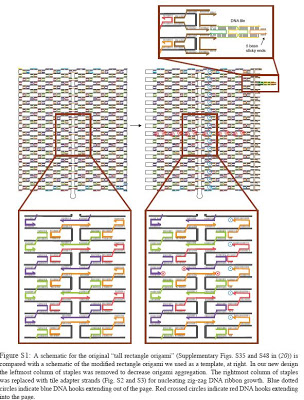A central challenge in nanotechnology is the parallel fabrication of complex geometries for nanodevices. Here we report a general method for arranging single-walled carbon nanotubes in two dimensions using DNA origami—a technique in which a long single strand of DNA is folded into a predetermined shape. We synthesize rectangular origami templates (75 nm 95 nm) that display two lines of single-stranded DNA ‘hooks’ in a cross pattern with 6 nm resolution. The perpendicular lines of hooks serve as sequence-specific binding sites for two types of nanotubes, each functionalized non-covalently with a distinct DNA linker molecule. The hook-binding domain of each linker is protected to ensure efficient hybridization. When origami templates and DNA-functionalized nanotubes are mixed, strand displacement-mediated deprotection and binding aligns the nanotubes into cross-junctions. Of several cross-junctions synthesized by this method, one demonstrated stable field-effect transistor-like behaviour. In such organizations of electronic components, DNA origami serves as a programmable nanobreadboard; thus, DNA origami may allow the rapid prototyping of complex nanotube-based structures.
This work someday may lead to the development of novel types of nanoscale electronic devices, an interdisciplinary team of researchers at the California Institute of Technology (Caltech) has combined DNA’s talent for self-assembly with the remarkable electronic properties of carbon nanotubes, thereby suggesting a solution to the long-standing problem of organizing carbon nanotubes into nanoscale electronic circuits.
“We expect that our approach can be improved and extended to reliably construct more complex circuits involving carbon nanotubes and perhaps other elements including electrodes and wiring,” Goddard says, “which we anticipate will provide new ways to probe the behavior and properties of these remarkable molecules.”
The real benefit of the approach, he points out, is that self-assembly doesn’t just make one device at a time. “This is a scalable technology. That is, one can design the origami to construct complex logic units, and to do this for thousands or millions or billions of units that self-assemble in parallel.”

In (a), single-wall carbon nanotubes labeled with “red” and “blue” DNA sequences attach to anti-red and anti-blue strands on a DNA origami, resulting in a self assembled electronic switch. In (b), an atomic force microscopey image of one such structure. The blue nanotube appear brighter because it is on top of the origami; the red nanotube sits below. Scale bar is 50 nm. In (c), a diagrammatic view of the structure shown in b. The gray rectangle is the DNA origami. A self-assembled DNA ribbon attached to the origami improves structural stability and ease of handling. Credit: Paul W. K. Rothemund, Hareem Maune, and Si-ping Han/Caltech/Nature Nanotechnology
20 page pdf with supplemental information
Open questions
The protocols described in this paper describe sufficient conditions for the creation of SWNT crossjunction devices. However, there remain open questions concerning what the simplest necessary procedure for creating cross-junction devices might be, as well as what parts of the protocol are most important for success:
1.LNA versus DNA toeholds
Five nucleotide LNA toeholds give good results. We have been unable to find conditions under which 7 and 8 nucleotide DNA toeholds give good results.
2.Plain origami versus origami with ribbons.
The use of ribbons with DNA origami appeared to increase the yield of observed. structures. This needs to be rigorously quantified and other options investigated.
3.Hooks with versus hooks without poly-T segments. Yield and alignment as a function of flexibility.
4. Schemes using strand displacement versus other protected schemes without strand displacement.
5.SWNT alignment as a function of NL-SWNT purity.
6.Why are the ends of nanotubes so often flush with the edges of DNA origami?
7. What is the detailed structure of the linkers on the SWNT and how does this affect alignment?
8. What is the nature of the barrier between SWNTs in our system? Can the intervening DNA layer act as a dielectric?

Brian Wang is a Futurist Thought Leader and a popular Science blogger with 1 million readers per month. His blog Nextbigfuture.com is ranked #1 Science News Blog. It covers many disruptive technology and trends including Space, Robotics, Artificial Intelligence, Medicine, Anti-aging Biotechnology, and Nanotechnology.
Known for identifying cutting edge technologies, he is currently a Co-Founder of a startup and fundraiser for high potential early-stage companies. He is the Head of Research for Allocations for deep technology investments and an Angel Investor at Space Angels.
A frequent speaker at corporations, he has been a TEDx speaker, a Singularity University speaker and guest at numerous interviews for radio and podcasts. He is open to public speaking and advising engagements.



